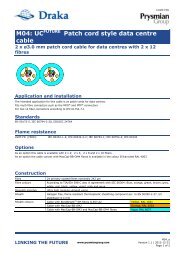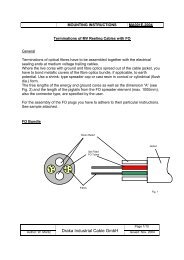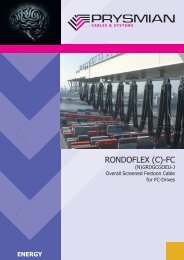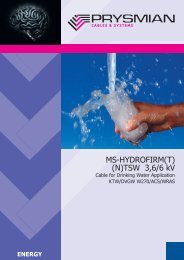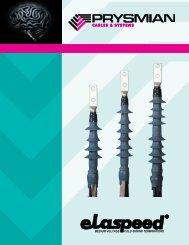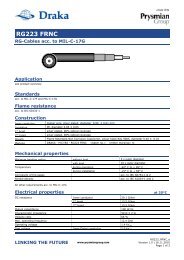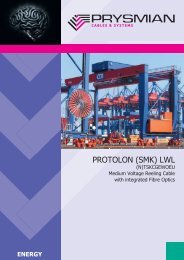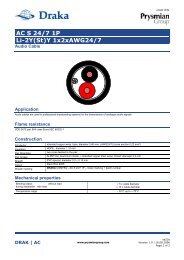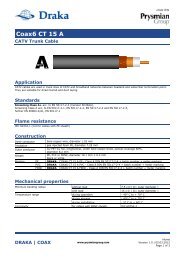Download 33kv Copper Cables Brochure - Prysmian
Download 33kv Copper Cables Brochure - Prysmian
Download 33kv Copper Cables Brochure - Prysmian
- No tags were found...
Create successful ePaper yourself
Turn your PDF publications into a flip-book with our unique Google optimized e-Paper software.
TECHNICAL INFORMATIONMAXIMUM SIDEWALL BEARING PRESSUREAnother factor which can limit the maximum tensionthat a cable can withstand is the sidewall bearingpressure exerted on a cable in duct bends and elbows.The sidewall bearing pressure formula is expressed as:SWBP = [W 2 + (T/(0.0098 x R)) 2 ] (equation 1)as most of the time, [T/(0.0098 x R)] 2 >> W 2equation 1 can therefore be simplified as follows:SWBP ≈ T/(0.0098 x R) (equation 2)From eqn. 2 => T = 0.0098 x R x SWBP (equation 3)From eqn. 2 => R = T / (0.0098 x SWBP) (equation 4)Where: SWBP = sidewall bearing pressure (kg/m)W = weight of cable per unit length (kg/m)T = cable pulling tension (kN)R = radius of the bend or elbow (m)The recommended maximum SWBP for sheathed cablesshall be 1450kg/m.Examples:1. To find out the maximum pulling tension of a12.7/22kV 240mm 2 copper single core PVC sheathedcable based on its minimum recommended bendingradius:First calculate the minimum recommended bendingradius without considering SWBP:= 18 x Cable Diameter= 18 x 40.5mm= 729mmThen calculate the maximum pulling tensions:a) Maximum pulling tension for straight pull:T = 0.07 kN/mm 2 x 240 mm 2= 16.8 kNb) Maximum pulling tension when taking maximumSWBP into consideration.From Equation 3: T = 0.0098 x 0.729 x 1450= 10.4 kNWe have to select the lesser of the two pulling tensions,i.e. 10.4kN. In this example, the maximum SWBPdictates the maximum pulling tension.2. To find out the minimum bending radius for the samecable if we do need a pulling tension of 16.8kN:JOINTS AND TERMINATIONSWhilst jointing and terminating of Medium VoltagePolymeric <strong>Cables</strong> is routine, care is needed to maintainclean working conditions and in ensuring that theinsulation semiconducting screen is completely removedand properly connected at the stress control areas.Reference should be made to literature for suitablesystems available from <strong>Prysmian</strong>.TESTS AFTER INSTALLATIONHigh Voltage d.c. testing of primary insulation is notrecommended and can be detrimental to the cable andaccessories. AS/NZS 1429.1 describes an a.c. voltage testat power frequency that should be applied for 24 hoursat the normal operating voltage of the system. A sheathintegrity test (e.g. with a 1000 Volt minimum ratedinsulation resistance tester) may be applied betweenthe outer-most metallic layer and the earth to identifypost-installation damage, provided the metallic layer isisolated from earth at the joints, terminations, etc.SHORT CIRCUIT FORCESWhen single core cables are installed touching, specialattention should be given to cleating and strappingarrangements to contain the repulsive forces undershort circuit conditions. Longitudinal thrust andtensions in cable conductors may be considerable andmay cause buckling of conductors and other damagein a joint or termination. When cables are installed,provision should be made to accommodate the resultinglongitudinal forces on terminations and joints. Sharpbends and fixings at a bend should be avoided.PREVENTION OF MOISTURE INGRESSCare should be exercised during installation to avoidany damage to cable coverings. This is important in wetor other aggressive environments. The protective capshould not be removed from the ends of the cable untilimmediately prior to termination or jointing. When thecaps have been removed the unprotected ends of thecable should not be exposed to moisture.The possibility of damage to moisture seals duringhandling and installation or during storage of the cableshould be considered and where such damage may haveoccurred, the seals should be inspected and remade ifnecessary.From Equation 4: R = 16.8 / (0.0098 x 1450)= 1.2m137




